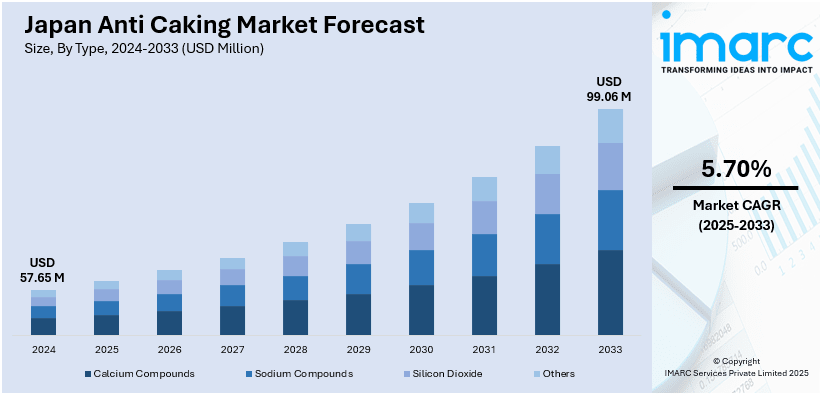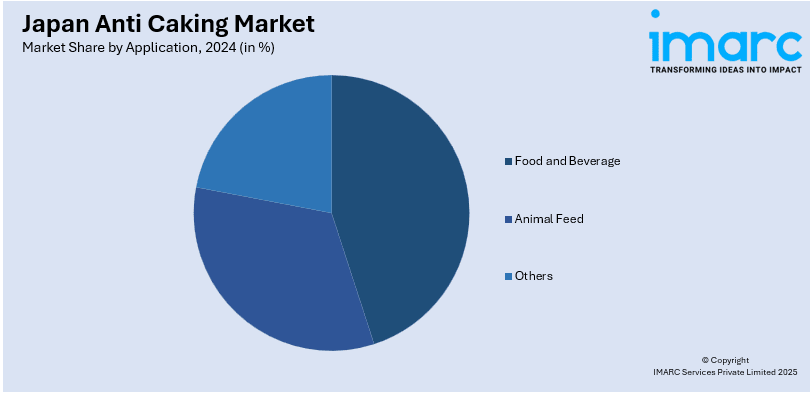
Japan Anti Caking Market Size, Share, Trends and Forecast by Type, Application, and Region, 2025-2033
Japan Anti Caking Market Overview:
The Japan anti caking market size reached USD 57.65 Million in 2024. Looking forward, IMARC Group expects the market to reach USD 99.06 Million by 2033, exhibiting a growth rate (CAGR) of 5.70% during 2025-2033. The market is driven by growing packaged food demand, rising pharmaceutical production, expanding animal feed industry, increasing consumer preference for convenience foods, stringent quality regulations, ongoing advancements in food processing, and rising industrial applications, fostering steady growth in food, agriculture, and manufacturing sectors.
|
Report Attribute
|
Key Statistics
|
|---|---|
|
Base Year
|
2024 |
|
Forecast Years
|
2025-2033
|
|
Historical Years
|
2019-2024
|
| Market Size in 2024 | USD 57.65 Million |
| Market Forecast in 2033 | USD 99.06 Million |
| Market Growth Rate 2025-2033 | 5.70% |
Japan Anti Caking Market Trends:
Growing Demand for Clean-Label and Natural Anti-Caking Agents
The rising consumer preference for clean-label and natural ingredients is driving demand for organic and plant-based anti-caking agents in Japan. Manufacturers have replaced synthetic additives silicon dioxide and calcium silicate with natural additives that include rice flour alongside starches and plant-derived cellulose because consumers are more focused on healthy food choices. For instance, Japan's Ministry of Health, Labour and Welfare (MHLW) proposed removing 78 food additives in June 2023, including certain anti-caking agents, from the approved list, due to their limited market usage. This underscores the importance of compliance and market relevance for manufacturers. Moreover, the Japanese regulatory bodies along with food safety authorities promote this transition toward safer and eco-friendly sustainable anti-caking solutions which drives businesses to invest in development. Besides this, the increasing consumer demand for transparent ingredients, transparency, and labeling has motivated brands to reformulate their products with few additives while preserving stability along with shelf life. Furthermore, the processed food sector, dairy industry, and spices manufacturing require free-flowing materials that do not affect product quality at any stage of production or distribution, thus enhancing the Japan anti caking market outlook.

Expansion of the Processed and Packaged Food Industry
The rising reliance on processed and packaged foods is significantly boosting the Japan anti caking market share. In line with this, the market growth for ready-to-eat (RTE) meals, instant soups, powdered beverages, and snack foods is increasing because of fast-paced urban lifestyles as well as an aging population and the increasing number of single-person households. Anti-caking agents function fundamentally to stabilize food consistency while stopping water uptake and extending product shelf life for multiple food products. Additionally, Japanese food safety regulations encourage manufacturers to adopt anti caking agents by requiring multiple quality control standards for the food industry. Moreover, the food industry innovates new formulation methods for better flowability which maintains both taste and nutritional value. For example, CJ Japan, part of CJ Food & Nutrition Tech, presented its innovative fermentation-based ingredient solutions at Hi Japan 2023. Their 'Nrich' brand features products such as TasteNrich® for sodium reduction and AMINATURE®, a plant-based line of amino acids. Apart from this, manufacturers are making strong investments in anti caking solutions that combine uninterrupted product stability with advancing consumer demands, aligning with regulatory compliance, and driving the Japan anti caking market growth.
Japan Anti Caking Market Segmentation:
IMARC Group provides an analysis of the key trends in each segment of the market, along with forecasts at the regional level for 2025-2033. Our report has categorized the market based on type and application.
Type Insights:
- Calcium Compounds
- Sodium Compounds
- Silicon Dioxide
- Others
The report has provided a detailed breakup and analysis of the market based on the type. This includes calcium compounds, sodium compounds, silicon dioxide, and others.
Application Insights:

- Food and Beverage
- Animal Feed
- Others
A detailed breakup and analysis of the market based on the application have also been provided in the report. This includes food and beverage, animal feed, and others.
Regional Insights:
- Kanto Region
- Kansai/Kinki Region
- Central/Chubu Region
- Kyushu-Okinawa Region
- Tohoku Region
- Chugoku Region
- Hokkaido Region
- Shikoku Region
The report has also provided a comprehensive analysis of all the major regional markets, which include Kanto Region, Kansai/Kinki Region, Central/Chubu Region, Kyushu-Okinawa Region, Tohoku Region, Chugoku Region, Hokkaido Region, and Shikoku Region.
Competitive Landscape:
The market research report has also provided a comprehensive analysis of the competitive landscape. Competitive analysis such as market structure, key player positioning, top winning strategies, competitive dashboard, and company evaluation quadrant has been covered in the report. Also, detailed profiles of all major companies have been provided.
Japan Anti Caking Market News:
- In November 2024, Japan’s government invested $7.8M in AI-powered culinary robots, revolutionizing food service by improving production efficiency and consistency. This initiative drove the demand for anti-caking agents, ensuring product quality, stability, and shelf life in automated food processing.
- In July 2023, Shin-Etsu Chemical launched an eco-friendly calcium silicate anti-caking agent series, aligning with the growing consumer preference for sustainable and natural additives. This product line supports manufacturers in offering clean-label products, thereby driving market growth.
Japan Anti Caking Market Report Coverage:
| Report Features | Details |
|---|---|
| Base Year of the Analysis | 2024 |
| Historical Period | 2019-2024 |
| Forecast Period | 2025-2033 |
| Units | Million USD |
| Scope of the Report | Exploration of Historical Trends and Market Outlook, Industry Catalysts and Challenges, Segment-Wise Historical and Future Market Assessment:
|
| Types Covered | Calcium Compounds, Sodium Compounds, Silicon Dioxide, Others |
| Applications Covered | Food and Beverage, Animal Feed, Others |
| Regions Covered | Kanto Region, Kansai/Kinki Region, Central/Chubu Region, Kyushu-Okinawa Region, Tohoku Region, Chugoku Region, Hokkaido Region, Shikoku Region |
| Customization Scope | 10% Free Customization |
| Post-Sale Analyst Support | 10-12 Weeks |
| Delivery Format | PDF and Excel through Email (We can also provide the editable version of the report in PPT/Word format on special request) |
Key Questions Answered in This Report:
- How has the Japan anti caking market performed so far and how will it perform in the coming years?
- What is the breakup of the Japan anti caking market on the basis of type?
- What is the breakup of the Japan anti caking market on the basis of application?
- What are the various stages in the value chain of the Japan anti caking market?
- What are the key driving factors and challenges in Japan anti caking?
- What is the structure of the Japan anti caking market and who are the key players?
- What is the degree of competition in the Japan anti caking market?
Key Benefits for Stakeholders:
- IMARC’s industry report offers a comprehensive quantitative analysis of various market segments, historical and current market trends, market forecasts, and dynamics of the Japan anti caking market from 2019-2033.
- The research report provides the latest information on the market drivers, challenges, and opportunities in the Japan anti caking market.
- Porter's five forces analysis assist stakeholders in assessing the impact of new entrants, competitive rivalry, supplier power, buyer power, and the threat of substitution. It helps stakeholders to analyze the level of competition within the Japan anti caking industry and its attractiveness.
- Competitive landscape allows stakeholders to understand their competitive environment and provides an insight into the current positions of key players in the market.
Need more help?
- Speak to our experienced analysts for insights on the current market scenarios.
- Include additional segments and countries to customize the report as per your requirement.
- Gain an unparalleled competitive advantage in your domain by understanding how to utilize the report and positively impacting your operations and revenue.
- For further assistance, please connect with our analysts.
 Request Customization
Request Customization
 Speak to an Analyst
Speak to an Analyst
 Request Brochure
Request Brochure
 Inquire Before Buying
Inquire Before Buying




.webp)




.webp)












